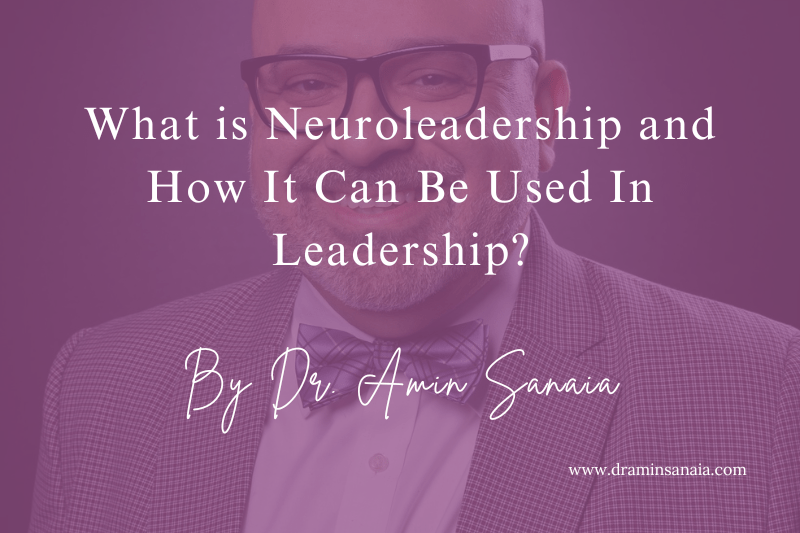What is Neuroleadership and How It Can Be Used In Leadership?

Hey, I am Dr. Amin Sanaia, a leaderologist, and I want to share with you the importance of neuroleadership.
We can say that it is a revolutionary approach that merges insights from neuroscience with leadership principles.
This fusion aims to optimize how organizations perform by better understanding human behavior, cognition, and emotions.
What is Neuroleadership?
It is where brain science meets leadership.
While neuroscience helps us understand how the brain works, leadership focuses on guiding and influencing people to achieve shared goals.
Combining these fields allows leaders to make smarter decisions and create better work environments.
Key Aspects of Neuroleadership
How Can Neuroleadership Improve Decision-Making?
A leader who understands cognitive biases may recognize when their team is falling prey to “groupthink,” where the desire for harmony leads to poor decision-making. By being aware of this, the leader can encourage diverse viewpoints and critical thinking.
It helps leaders understand how the brain processes information and makes decisions.
By learning about cognitive biases, leaders can avoid common decision-making pitfalls and make more informed choices.
How Does Emotional Intelligence Fit into Neuroleadership?
During a stressful project, a leader with high emotional intelligence might notice signs of burnout in team members and take steps to address it, such as offering support or adjusting deadlines.
Recognizing and managing emotions is crucial for effective leadership.
It teaches leaders how to navigate complex situations with empathy and clarity, leading to better outcomes.
It can Boost Engagement and Productivity?
A manager who leverages the brain’s social circuitry might implement regular team-building activities to strengthen bonds and increase motivation.
Techniques from neuroleadership can enhance how engaged and productive employees are.
By understanding the brain’s social and emotional drivers, leaders can create a motivating and collaborative work environment.
How Does It can Build Trust and Psychological Safety?
A leader who promotes psychological safety might encourage open communication and ensure that team members feel their ideas are valued, leading to higher engagement.
Trust and a sense of safety are vital for high employee engagement.
When employees feel valued and respected, they are more likely to be committed to their work and contribute positively to the organization.
What Are the Emerging Trends in Neuroleadership?
Modern tools like AI-driven analytics can help leaders understand team dynamics and individual performance better, enabling more personalized leadership approaches.
New trends includes the use of technology to support leadership practices.
This can involve tools that help leaders understand their teams better and improve communication.
Why Neuroleadership Matters?
The real strength of neuroleadership lies in applying brain science to enhance leadership effectiveness. By leveraging insights from neuroscience, leaders can:
- Make better decisions
- Handle emotional dynamics skillfully
- Increase employee motivation and collaboration
- Make a trustworthy and safe work environment
In essence, It equips leaders with the knowledge to improve how they lead, ultimately driving better organizational performance.
If you have read this, you are awesome. Connect with me on my YouTube channel for visual information.
Plus If you want to receive direct messages, join my Instagram army.
Source:
Davis, R., & Thompson, L. (2023). The Impact of Emotional Regulation on Team Dynamics: Insights from Neurobiological Studies. Leadership Science Quarterly, 14(4), 337-355.
Patel, V., & Kim, S. (2021). Empathy and the Mirror Neuron System: Implications for Neuroleadership. Journal of Applied Neuroscience, 16(1), 29-48.
Johnson, E., & Fernandes, L. (2022). Resilient Brains: Neuroplasticity and Stress Management in Organizational Settings. Journal of Workplace Behavioral Health, 37(2), 145-163.
Klimecki, O. M., Leiberg, S., Lamm, C., & Singer, T. (2012). Functional Neural Plasticity and Associated Changes in Positive Affect After Compassion Training. Cerebral Cortex, 23(7), 1552-1561.
The power of neuroleadership: how neuroscience is revolutionizing …. https://www.brainelem.com/post/the-power-of-neuroleadership-how-neuroscience-is-revolutionizing-leadership.
Change in Weeks, Not Years – NeuroLeadership Institute. https://neuroleadership.com/.
Neuroleadership: Enhancing Management with Neuroscience Principles. https://businessner.com/neuroleadership-enhancing-management-with-neuroscience-principles/.
Neuroleadership: Combining Neuroscience and Organization Skills. https://exploringyourmind.com/neuroleadership-combining-neuroscience-and-organizational-skills/.